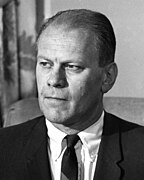This article needs additional citations for verification. (March 2024) |
| |||||||||||||||||||||||||||||||||||||
All 435 seats in the United States House of Representatives 218 seats needed for a majority | |||||||||||||||||||||||||||||||||||||
|---|---|---|---|---|---|---|---|---|---|---|---|---|---|---|---|---|---|---|---|---|---|---|---|---|---|---|---|---|---|---|---|---|---|---|---|---|---|
| |||||||||||||||||||||||||||||||||||||
 Results: Democratic hold Democratic gain Republican hold Republican gain | |||||||||||||||||||||||||||||||||||||
| |||||||||||||||||||||||||||||||||||||
The 1968 United States House of Representatives elections were elections for the United States House of Representatives on November 5, 1968, to elect members to serve in the 91st United States Congress. They coincided with Richard M. Nixon's election as president. Nixon's narrow victory[1] yielded only limited gains for his Republican Party, which picked up a net of five seats from the Democratic Party. The Democrats retained a majority in the House.
The election coincided with the presidential campaign of George Wallace of the American Independent Party, who unsuccessfully attempted to deny a majority in the Electoral College to any of his opponents. Had Wallace succeeded he would have given the House the choice of president from among the three, for the first time since 1825. As a result of this election, Democrats formed a majority of 26 state House delegations, with Republicans forming a majority in 19 and the other five delegations being evenly split (each state's House delegation receives one vote in such an election). However, the Democrats' nominal majority of state delegations includes those of the Southern United States who were more inclined to support Wallace as opposed to Democratic candidate Hubert Humphrey. Wallace believed the Southern representatives would be able to use the clout his campaign was trying to give them to force an end to federal desegregation efforts in the South.
- ^ "CQ Almanac Online Edition". library.cqpress.com. Retrieved 2024-03-28.

